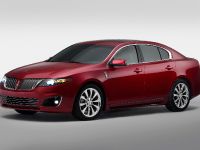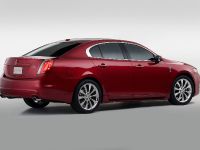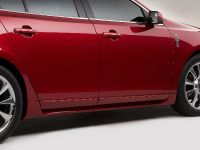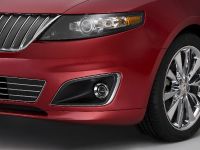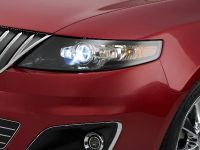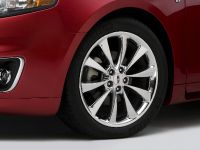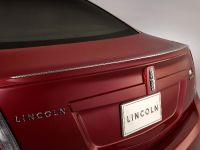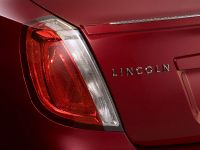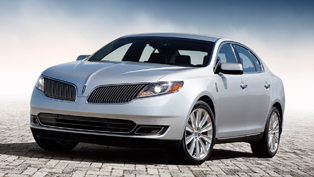Fuel-Efficient New V-6 Engine Gives Flagship Lincoln Mks The Power Of A V-8
Launched last summer, the Lincoln MKS upholds the luxury and comfort standards unique to Lincoln. Now, with the addition of all-new EcoBoost engines, the Lincoln MKS also will deliver a compelling combination of V-8 power and V-6 fuel economy.
The Lincoln MKS is among the first Ford Motor Company vehicle to introduce a premium twin-turbocharged 3.5-liter EcoBoost V-6 engine for the 2010 model year and is expected to deliver best-in-class highway fuel economy of 25 mpg. By 2013, more than 90 percent of Ford Motor Company's North American lineup will be available with EcoBoost technology.
"We are committed to delivering fuel economy leadership in every new vehicle," said Derrick Kuzak, Ford's group vice president of Global Product Development. "We do this with affordable technology that can be applied to the widest number of vehicles. EcoBoost is an important component of that goal.
"The beauty of EcoBoost is that it enables us to downsize for fuel efficiency, yet boost for power. We're able to decrease the size of the available engine – such as installing a V-6 versus a V-8 – yet boost the power using turbocharging to deliver similar power and torque of that larger engine."
The 3.5-liter EcoBoost V-6 is expected to attain fuel economy numbers of 16 mpg city and 25 mpg highway based on preliminary testing of the all-wheel-drive 2010 Lincoln MKS while producing an estimated 355 horsepower at 5,700 rpm and 350 lbs.-ft. of torque at 3,500 rpm.
With its premium EcoBoost engine, the new Lincoln MKS will deliver more power and better highway fuel efficiency than the 2009 Lexus GS460 (24 mpg) or 2009 Infiniti M45 (21 mpg).
"We're delighted with how well the Lincoln MKS has been received. Customers have really responded to the vehicle's balanced combination of luxury, comfort and performance," said Pete Reyes, chief nameplate engineer. "Adding the 3.5-liter EcoBoost V-6 is another great enhancement to our luxury sedan. We now can deliver V-8 power without sacrificing fuel economy."
The Lincoln MKS will be among the first vehicles to receive the 3.5-liter EcoBoost V-6 starting in the summer of 2009, enhancing what's already a strong package. Standard on the Lincoln MKS EcoBoost series will be 19-inch wheels, steering-wheel paddle shifters to the six-speed SelectShift® automatic transmission, all-wheel drive and an expanded technology package that includes Intelligent Access with Push Button Start, ambient lighting, adaptive HID headlamps with Auto Highbeam, rain-sensing wipers and rear-window power sunshade.
"The Lincoln MKS EcoBoost series provides customers the best combination in style, technology and power," said Pei-Wen Hsu, Lincoln MKS Marketing manager. "An EcoBoost appearance package also will be available, offering customers a more aggressive and sporty look that further differentiates the Lincoln MKS from other competitors."
The EcoBoost program is part of Ford's ongoing and wide-ranging initiative to deliver innovative fuel-efficient powertrain systems with horsepower and torque performance found in larger-displacement engines.
"Our EcoBoost engines offer more power and better fuel economy," said Brett Hinds, EcoBoost design manager. "It's all part of Ford's strategy to bring adaptable powertrain technology to all kinds of vehicles and all kinds of lifestyles. This technology is affordable and applicable to all gasoline engines."
The turbochargers recover energy from the exhaust that otherwise would be wasted and put it back in the engine to gain efficiency. Simply, the turbocharging system puts more air into the engine for more power. A compressor increases or "boosts" the pressure of the air entering the engine. An intercooler reduces the air temperature before it enters the engine.
The twin parallel turbochargers, which are water-cooled and operate simultaneously, combine with a direct-injection fuel system to produce power when the driver pushes down on the accelerator pedal. The high-pressure fuel pump operates up to 2,175 psi – more than 35 times the norm seen in a conventional V-6 engine. The high-pressure pump is a cam-driven mechanical pump with a single piston and an electronic valve that controls how much fuel is routed into the fuel rails to the injectors.
As demands on the twin-turbocharged 3.5-liter EcoBoost V-6 engine are increased, the control system responds to maintain optimal combustion, timing and injection duration.
On each stroke, six individual jets spray fuel directly into the combustion chamber, mixing with the incoming air. "By bringing the fuel injector right into the combustion chamber, there's no delay from the time you inject the fuel to when it's used by the engine," Hinds said.
The fuel injectors are located on the side of the combustion chamber. When the fuel is injected into the cylinder, it evaporates and cools the air that's been inducted into the cylinder. "Another benefit of our direct-injection method is that it cools the air right where you're going to burn it," Hinds said. "This action both improves the breathing of the engine and minimizes knocking."
The direct injection of fuel into the cylinder also helps provide a well-mixed air-fuel charge, increasing engine efficiency. Direct injection provides several benefits in terms of fuel burn and lower emissions.
"Because the fuel is directly introduced into the combustion chamber, you don't get fuel wetting the combustion wall like with port fuel injection, you don't saturate the ports and you don't get droplets that might recombine and add to saturation," Hinds said. "By injecting fuel directly into the combustion chamber and under high pressure, the fuel can be directed to exactly where we want it to be for a given combustion cycle."
The spray pattern for the fuel was optimized after extensive computer modeling work, with the angle of how the fuel is sprayed key to the process. "The better combustion process is a big advantage of direct injection," Hinds said. "In a port fuel system, at key off it's possible to have fuel on the walls of the intake port, which migrates to the top of the valve and puddles. So when you key on, you get that emissions spike. Direct injection is much cleaner from that standpoint."
Turbo lag virtually eliminated The simultaneous turbocharger operation paired with the direct-injection system help to virtually eliminate turbo lag, one of the main reasons turbocharger technology was not previously more widely used.
The dual-turbocharger setup has several advantages over previous turbocharging systems, including:
- The turbochargers are smaller, resulting in more-compact exhaust manifolds, which don't generate as much heat
- Turbochargers are packaged adjacent to the cylinder block and have improved mounting providing NVH (noise, vibration, harshness) improvements
- The dual turbochargers spool up quicker, allowing the 3.5-liter EcoBoost V-6 engine to reach peak torque faster. The turbochargers spin at approximately 170,000 rpm. By comparison, the redline for the engine is approximately 6,500 rpm
"The two turbochargers both operate identically over the speed range of the engine – one is responsible for the left bank of the engine and the other is responsible for the right bank," Hinds said. "Both spin immediately and produce boost, even at low engine speeds."
The turbochargers are designed for a life cycle of 150,000 miles or 10 years.
"Our testing is far, far more harsh than could be achieved in the real world," Hinds. "In an extreme situation, a customer might be able to hit peak power for about 10 seconds – probably not even that much. We test at peak power for hundreds of hours to ensure we can reach our durability and reliability goals."
The turbochargers are only about the size of an orange, but help provide a big performance advantage to customers. Hinds describes the torque response in terms of linear acceleration – power whenever you need it.
"You get peak torque across a very wide engine speed range," he said. "It's available when you pull away from a stoplight or pass someone on a secondary road at a comparatively low speed. You don't need to wind up the engine to get performance out of it. It's there all the time."
Turbocharger "whoosh" is mitigated by electronically controlled anti-surge valves, which proactively relieve the boost in the intake, which can range up to 12 PSI. Careful software calibrations manage the pressures in the intake manifold.
"We control the boost to make sure that customers don't recognize when the boost is building," Hinds said. "As the turbochargers spool up, the electronic control system takes over. Our active wastegate control along with the throttle controls the boost and torque levels very precisely and the customer perceives a continuous delivery of torque."
Extensive durability tests on the twin-turbocharged 3.5-liter EcoBoost V-6 engine ensure it will excel in all conditions. Start-up tests, with a wide variety of fuels, were made in conditions ranging from minus 40 to 110 degrees Fahrenheit. Altitude testing up to 12,000 feet in Colorado also was performed.
"The direct-injection fuel system allows us some real opportunities in terms of optimizing cold start for both emissions and robustness," Hinds said. "We have multiple injections for each combustion event, and we can essentially tune where those injections should take place to deliver the strongest start possible with the lowest emissions."
Mated to the 3.5-liter EcoBoost V-6 engine is the 6-speed 6F-55 SelectShift automatic transmission, which is dedicated to the twin-turbocharger engine. The 6F-55 transmission was developed from the successful 6F-50 transmission to specifically respond to the increased torque demands of the EcoBoost V-6 engine. Upgrades were made to the transmission's friction material in response to the higher shift energies, and a new torque converter has been optimized for performance and fuel economy.
Additionally, the 6F-55 transmission operates more efficiently. The transmission team was able to reduce the fluid level in the transmission, which in turn reduced weight and drag torque on the system. Upgrades to the transmission's thermal valve mean the system warms up quicker, reducing gear-spin losses.
"We've upgraded the gear sets to handle the increased torque," said Joe Baum, powertrain team leader. "We've also adjusted the final drive ratio and matched the gear ratios to provide the optimum performance and fuel economy.
"Our final drive ration is 2.73. With a lower final drive ratio, the engine spins lower at highway speeds, which helps save fuel. And with all the torque, the Lincoln MKS still delivers good low-speed launch performance."
One harmonious system Careful powertrain system management ensures the engine, turbochargers and transmission work together harmoniously.
The Lincoln MKS team also was careful to give customers an exhaust note from the 3.5-liter EcoBoost V-6 that was pleasing but not overpowering. A precision-tuned induction sound tube directed into the cabin complements the feeling of power.
"It has the powerful sound Lincoln MKS customers will respond to," Hinds said.
With the addition of the twin-turbocharged 3.5-liter EcoBoost V-6, the overall package for the Lincoln MKS is one customers will respond to as well.
"With its elegant styling, wide suite of convenience technology and incomparable ride, the Lincoln MKS is an outstanding luxury sedan," Reyes said. "We're pleased and proud to add the 3.5-liter EcoBoost V-6 to an already-great car."
